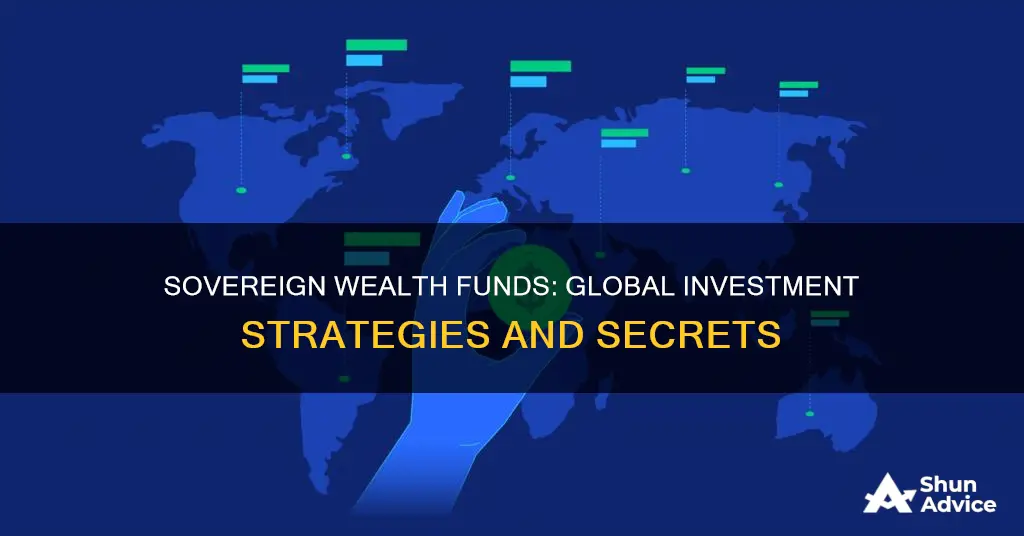
Sovereign Wealth Funds (SWFs) are state-owned investment funds that invest in both real and financial assets, such as stocks, bonds, real estate, precious metals, and alternative asset classes. SWFs are usually established using balance of payments surpluses, official foreign currency reserves, proceeds of privatizations, government transfer payments, fiscal surpluses, and/or receipts from commodity exports. The funds are typically owned by the general government, including both central and sub-national governments, and they invest with financial objectives in mind. SWFs have a variety of purposes, including stabilizing the economy, generating wealth for future generations, and funding social and economic development.
| Characteristics | Values |
|---|---|
| Fund type | Sovereign Wealth Fund (SWF) |
| Ownership | State-owned |
| Investment type | Real and financial assets |
| Examples of real assets | Oil fields, precious metals, real estate, infrastructure |
| Examples of financial assets | Stocks, bonds, ETFs |
| Investment purpose | Strategic, long-term economic priorities |
| Sources of funding | Balance of payments surpluses, official foreign currency operations, proceeds of privatizations, government transfer payments, fiscal surpluses, receipts from resource exports |
| Fund classifications | Stabilization funds, savings and future generations funds, pension reserve and future liabilities funds, reserve investment funds, strategic development sovereign wealth funds (SDSWFs) |
| Number of SWFs globally | 120 (as of November 2017) |
What You'll Learn

Equities, debt securities, real estate, resource extraction and other assets
Sovereign wealth funds (SWFs) invest in a variety of asset classes, including equities, debt securities, real estate, resource extraction, and other assets.
Equities
SWFs often invest in equities, or stocks, as part of their portfolio. This can include investing in publicly listed financial assets, as well as global public equities. For example, Norway's Government Pension Fund Global reported that in 2024, 70.9% of its fund was invested in equities.
Debt Securities
Debt securities, such as bonds, are another common investment for SWFs. These can include government bonds, corporate bonds, or other fixed-income securities.
Real Estate
Real estate is also a popular asset class for SWFs. This can include institutional real estate, such as commercial or residential properties, as well as infrastructure investments.
Resource Extraction
Many SWFs are financed by exporting commodities, particularly oil and gas. These funds are often established to invest excess revenues from these commodities and to diversify the country's economy away from a single resource dependence.
Other Assets
Other assets that SWFs may invest in include precious metals, private equity, hedge funds, venture capital, and infrastructure. They may also invest in domestic industries, startups, or renewable energy companies.
The specific investments made by SWFs can vary depending on the fund's objectives, risk tolerance, and the economic and strategic priorities of the host government. Some funds may take a more conservative approach, while others may have a higher risk tolerance and seek higher returns.
Mutual Fund Investment Strategies: Where to Invest?
You may want to see also

Stocks, bonds, precious metals, and alternative asset classes
Sovereign Wealth Funds (SWFs) are state-owned investment funds that invest in a variety of asset classes, including stocks, bonds, precious metals, and alternative asset classes.
Stocks
SWFs invest in equities, with the Norway Government Pension Fund Global, the world's largest SWF, reporting that 70.9% of its fund was invested in equity in 2023.
Bonds
Bonds are another key area of investment for SWFs, with the Norway fund allocating 27% of its portfolio to fixed income in 2023.
Precious Metals
Gold is often a component of SWFs, particularly those funded by commodity exports. Gold holdings can be significant, representing a country's foreign-exchange reserves.
Alternative Asset Classes
SWFs also invest in alternative asset classes such as real estate, private equity, and hedge funds. Institutional real estate, for example, has been a popular investment destination for SWFs, with direct deals in this sector amounting to $50.02 billion in the first half of 2014.
Overall, SWFs have a broad investment scope, and their asset allocation can vary depending on their specific objectives, risk tolerances, and liquidity needs.
Best Tracker Funds: Where to Invest Your Money
You may want to see also

Foreign direct investment
SWFs have become prominent global investors, with their assets under management (AUM) surpassing $11 trillion as of February 2023. The growth of SWFs has made them significant participants in international finance, particularly in private equity funding.
SWFs invest in a diverse range of industries and sectors through FDI. They target both developed and developing nations, with a focus on strategic industries such as telecommunications, finance, natural resources, and utilities. SWFs also seek opportunities in emerging markets and are increasingly investing in technology, healthcare, and consumer sectors.
The impact of SWF investment through FDI on target firms has been a subject of academic research. Studies have found that SWF investments can have both short-term positive effects and long-term negative consequences on target firm stock prices. Additionally, SWF investments may influence the cost of debt and equity financing for target firms.
The large capital available to SWFs makes finding suitable investment opportunities a challenge. Real estate and infrastructure, with their high capital requirements, are natural investment targets for SWFs. SWFs have also shown a growing interest in alternative investments, such as private equity and venture capital.
In conclusion, SWFs play a significant role in global FDI, and their investment strategies and impacts are closely monitored by academics and policymakers alike.
Mutual Funds: Exploring Superior Investment Opportunities
You may want to see also

Hedge funds or private equity
Sovereign wealth funds (SWFs) are state-owned investment funds that invest in both real and financial assets, including stocks, bonds, real estate, precious metals, and alternative asset classes. They are usually established using balance of payments surpluses, official foreign currency reserves, proceeds of privatizations, government transfer payments, fiscal surpluses, and/or receipts from commodity exports.
SWFs have traditionally been passive, long-term investors, but a growing number are turning to alternative investments such as hedge funds and private equity, which are not accessible to most retail investors. Hedge funds are typically structured as private partnerships domestically and as private Cayman corporations offshore. They are often criticised for being secretive and unregulated, but they do provide important market functions, such as ensuring markets are made up of investors with heterogeneous views of value.
Private equity firms are long-term, illiquid investment vehicles that typically take controlling positions in private operating companies. They are often funded by larger pools of capital, such as pension funds and charitable endowments, and have been criticised for their use of high debt loads to fund purchases. However, they can be trusted to serve their own profit motives and maximise the value of their holdings.
SWFs have five broad classifications:
- Stabilization funds
- Savings and future generations funds
- Pension reserve and future liabilities funds
- Reserve investment funds
- Strategic Development Sovereign Wealth Funds (SDSWFs) – the most prevalent
SDSWFs are used to further strategic, economic and/or national development priorities while generating a positive risk-adjusted return on their allocations. They tend to invest up to 50% of their assets domestically, with the rest spread across fixed-income securities, public equities, cash equivalents, and private market investments.
Cooperative vs Investment Fund: Understanding the Key Differences
You may want to see also

Venture capital, private equity, hedge funds, real estate, and infrastructure
Sovereign Wealth Funds (SWFs) are large institutional investors that manage billions of dollars of state capital. They are characterised by their extremely large size and long-term investment horizons.
SWFs have been increasingly investing in alternative assets such as venture capital, private equity, hedge funds, real estate, and infrastructure.
Venture Capital
SWFs have been increasing their investments in venture capital, particularly in disruptive industries and unlisted technology companies. In 2018, SWFs provided the most equity financing for unlisted technology companies since 2015, investing $3.4 billion over 44 deals. They also favoured private healthcare companies, completing 40 deals. SWFs' commitments to early-stage companies doubled in 2018 compared to the previous year, while the number of transactions at the growth-capital stage increased by over 40%.
Private Equity
SWFs are increasingly investing in private equity, with some sources stating that they are turning to alternative investments such as private equity and hedge funds. SWFs tend to invest in buyout funds more often than venture capital funds. They also tend to invest in larger funds that have a greater number of limited partners.
Hedge Funds
Some sources state that SWFs are turning to alternative investments such as hedge funds.
Real Estate
SWFs are cooling their investments in office properties and are instead investing in assets such as logistics, data centres, and smart infrastructure, which support changes in how people work and spend their leisure time.
Infrastructure
SWFs have been increasing their investments in infrastructure, particularly in sustainable investing.
Dividend Funds: When to Invest for Maximum Returns
You may want to see also
Frequently asked questions
A sovereign wealth fund (SWF) is a state-owned investment fund that invests in both real and financial assets. These assets include stocks, bonds, real estate, precious metals, and alternative asset classes.
Sovereign wealth funds invest in a wide range of asset classes, including foreign direct investment, hedge funds, private equity, real estate, infrastructure, and venture capital. They also invest in publicly listed financial assets.
There are five broad classifications of sovereign wealth funds: stabilization funds, savings and future generations funds, pension reserve and future liabilities funds, reserve investment funds, and strategic development sovereign wealth funds (SDSWFs).
Sovereign wealth funds provide several benefits, including economic stabilization, capital maximization, and strategic development. They help protect and stabilize budgets and economies, diversify from non-renewable commodity exports, and earn greater returns than on foreign exchange reserves.
Some examples of sovereign wealth funds include the Norway Government Pension Fund Global, China Investment Corporation, Abu Dhabi Investment Authority, and Kuwait Investment Authority.







